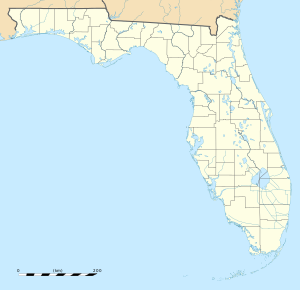Naval Outlying Landing Field Choctaw
| Naval Outlying Landing Field Choctaw Eglin Dillon Airdrome Eglin Air Force Auxiliary Field #10 | |||||||
|---|---|---|---|---|---|---|---|
| Located near: Pensacola, Florida | |||||||
 2006 USGS airphoto | |||||||
| Coordinates | 30°30′33″N 086°57′28″W / 30.50917°N 86.95778°W | ||||||
| Type | Military airfield | ||||||
| Site history | |||||||
| Battles/wars | World War II | ||||||
| Airfield information | |||||||
| Identifiers | IATA: NFJ, ICAO: KNFJ, FAA LID: NFJ, WMO: 725540 | ||||||
| Elevation | 31 metres (102 ft) AMSL | ||||||
| |||||||
Naval Outlying Landing Field Choctaw (IATA: NFJ, ICAO: KNFJ, FAA LID: NFJ) is the United States Navy's designation for an auxiliary airfield that was originally constructed during World War II as Eglin Field (now Eglin Air Force Base) Auxiliary Field # 10. It is located 16.6 miles northeast of Pensacola, Florida.
History
Constructed in Santa Rosa County, the westernmost of Eglin's ten satellite fields, Auxiliary Field 10 was originally named Dillon Field for Captain Barclay H. Dillon, United States Army Air Forces, a test pilot of the Fighter Section of the 1st Proving Ground Group, Eglin Field, killed 2 October 1943 when his P-38J-5-LO Lightning, AAF Ser. No. 42-67103, crashed 8 miles W of Milton, Florida.[1] Field 10 was later named Eglin Dillon Airdrome.[2]
The field was constructed in 1942 by the U.S. Army Air Forces as part of the Eglin Field military reservation. It initially consisted of three 4000' asphalt runways in an "A" type configuration. Runway 18/36 is now 8000' long with 1000' of overhang on each side and 150' wide. No ground station was constructed. It was transferred to the United States Navy in 1943 as NAF 05822 and was designated an Outlying Field for Naval Air Station Whiting Field. Now principally used for U.S. Navy primary flight training, the Navy refers to it as Outlying Landing Field Choctaw (OLF), a satellite field for Training Air Wing Six at Naval Air Station Pensacola and Training Air Wing Five at Naval Air Station Whiting Field.[3]
It is also used for unmanned aerial vehicle (UAV) training by the U.S. Air Force.[4]
It is expected that Air Force, Navy and Marine Corps F-35 Lightning IIs assigned to the 33d Fighter Wing at Eglin Air Force Base will utilize OLF Choctaw for training.[5]
See also
References
![]() This article incorporates public domain material from the Air Force Historical Research Agency
This article incorporates public domain material from the Air Force Historical Research Agency
- ^ "USAAF/USAF Accidents for Florida". Accident-Report.com. Archived from the original on 2014-10-07. Retrieved 2010-09-16.
- ^ Angell, Joseph W., "History of the Army Air Forces Proving Ground Command – Part One – Historical Outline 1933–1944", The Historical Branch, Army Air Forces Proving Ground Command, Eglin AFB, Florida, reprint by Office of History, Munitions Systems Division, Eglin Air Force Base, Florida, circa 1990, page 105.
- ^ "Factsheets : Eglin Air Force Base History". Eglin.af.mil. Archived from the original on 2010-12-27. Retrieved 2010-09-16.
- ^ "Archived copy" (PDF). Archived from the original (PDF) on 2011-07-18. Retrieved 2011-07-10.
{cite web}: CS1 maint: archived copy as title (link) - ^ Master Sergeant Russell P. Petcoff (2010-07-29). "Eglin chosen as preferred alternative F-35 base". Eglin.af.mil. Archived from the original on 2010-08-17. Retrieved 2010-09-16.
External links
- NOLF Choctaw at GlobalSecurity.org
